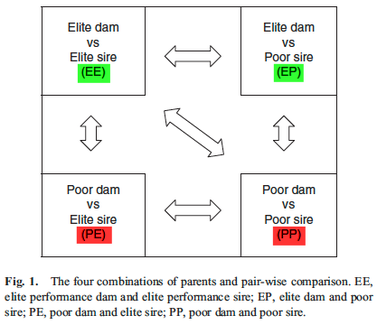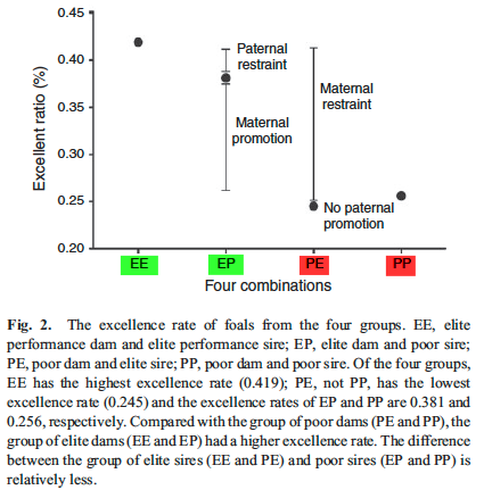A paper just out about horses has the dog people all atwitter. Provocatively titled "Potential role of maternal lineage in the thoroughbred breeding strategy", it examines the relative genetic influence of the sire and dam in racing performance as documented in terms of lifetime earnings (1).
| The researchers found that "elite" (top-winning) sires bred to elite dams were more likely to produce elite offspring, and likewise poor sires bred to poor dams produced poor offspring. But the kicker was that poor dams bred to elite sires tended to produce poor offspring, while elite dams breed to poor sires could produce excellent offspring. So a great sire can't compensate for a poor dam, but a great dam can produce a great performer with a poor quality sire. Aha! Just as that long-time dog breeder has always said, the dam is more important than the sire in your breeding program, and here finally are the data to prove it. In racehorses, yes. In dogs, no - and the reason becomes apparent if you read beyond the abstract of the paper. |
They found that 14% of the variation in performance among horses could be attributed to the genetic influence of the dam, but only 3.5% to the sire. Notice here the wording "variation in performance". This is NOT the same as saying that 14% of speed comes from the dam, which would be incorrect. It specifically references the variation in performance among the group of horses in the study, and attributes 14% of it to the genetics of the dam, while the 86% of variation that remains must be attributed to some other factors, which could include the paternal influence (which they found to be 3.5%) and all possible non-genetic factors that are collectively termed "environmental". The environmental factors could include any number of things - nutrition, exercise, stress level, environmental toxins, and even aspects of the maternal environment such as the dam's nutrition, and the interactions of foal and dam after birth.
How could the dam be contributing to the performance of her offspring in a way that the sire doesn't? After all, the sire and dam each contribute exactly half of the alleles on the autosomal chromosomes, which include all the chromosomes except the X and Y sex chromosomes. (For each gene on the autosomal chromosomes, there are two alleles - one that comes from the mother and one from the father.)
What the dam provides that the sire doesn't are the mitochondria, which are inherited solely from the mother (the mitochondria in the sperm are usually destroyed after fertilization). Mitochondria are organelles found in every cell of the body, and their job is to produce a molecule called ATP, which is the chemical "fuel" of the body. Without mitochondria you're dead. Literally.
The authors of this study speculate that variation in the maternally-inherited mitochondria could be contributing to the performance of offspring. Mitochondrial function has been linked to athletic performance (2), so presumably, inheritance of mitochondria that are more efficient at generating the ATP needed to fuel the body during a race provides the link between the performance of the dam and her offspring. The hypothesis that dams with more powerful mitochondria will pass the trait to their offspring would need to be tested by comparing the ATP production of mitochondria from elite versus poor performers.
Great mitochondria would not be a big benefit for the average dog either, except in extremely high-energy activities like racing or lure coursing. There is really nothing in this study that supports the notion that the "quality" of the dam is of greater importance than the sire in determining the quality of a litter of puppies. And as far as I'm aware, there are no data elsewhere that even address this in dogs. General statements in dog publications that the dam has some special importance to the quality of puppies are not supported by evidence. For example, one published years ago that is making the rounds again since publication of the horse paper, the author states that "the female or X chromosome is responsible for most of the highly desirable characteristics for which breeders strive" (3). The X chromosome carries only 5-10% of the genes, and these are responsible for a wide variety of things including production of specific enzymes, transcription factors, proteins for vision and muscle function, development of teeth, development of endocrine tissues and the nervous system, cell biochemistry, and many other things (4), all of which are essential and fundamental cellular functions but not "highly desirable characteristics" that would be under selection by dog breeders.
Good dams are probably more likely to produce good puppies than poor ones, and likewise for good sires, but the genetic contributions of the sire and dam to a puppy are essentially equal. So the "quality" of a puppy will be determined by which of the two alleles is inherited from each parent. If the dam really does has more to do with the quality of the puppies than the sire, it remains to be demonstrated by science.
2) Das J. 2006. The role of mitochondrial respiration in physiological and evolutionary adaptation. BioEssays 28: 890-901.
3) Andrews BJ. The genetic X factor.
4) National Institutes of Health. Genes on the X chromosome
*** Visit our FACEBOOK pages ***
ICB Institute of Canine Biology
...the latest canine news and research
ICB Breeding for the Future
...the science of animal breeding



